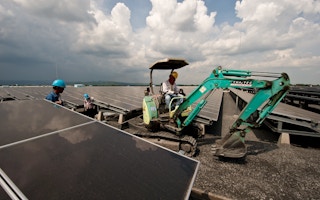Several East Asian power markets have emerged as high-potential investment destinations for renewables, a new clean energy ranking by multinational consultancy Ernst & Young (EY) shows.
The Renewable Energy Country Attractiveness Index, a biannual analysis that gauges how appealing wind and solar projects are to investors, finds that East Asia’s clean energy surge, conducive policy developments and climate commitments are driving a strong outlook for renewables in the region.
Seven East Asian nations once again clinched a spot on the list, even if some fell in the ranking, which comprises the world’s top 40 clean energy investment destinations.
Having rejoined the Paris climate accord and set a new emissions target, the United States retained its top position, but it is closely followed by China, with Japan coming in eighth. South Korea clinched 17th place, with Taiwan, the Philippines, Vietnam and Thailand ranked 28th, 31st, 34th, and 39th, respectively.
Taiwan, South Korea, Thailand and the Philippines all dropped in the ranking. China, Japan and Vietnam did not register changes in relative attractiveness.
“
All nations must urgently set actionable near-term targets, rather than kicking the can down the road. There is not much road left.
Arnaud de Giovanni, global renewables leader, Ernst & Young
It’s not just recent net-zero emissions pledges by major economies like China, South Korea and Japan that have piqued investors’ interest in the region. There are also bans on the financing of coal by countries like the Philippines, improvements in market design in nations like Vietnam, and Taiwan’s clear targets and roadmap.
Marking a new direction for the region, such developments provide financiers and developers with the visibility they need to venture into new markets.
In addition, energy demand in climate-vulnerable Southeast Asia is forecast to double by 2040 and energy planners increasingly recognise renewables’ potential to satisfy this soaring demand while slashing emissions and reducing dependence on coal.
“There is a clear and growing demand for renewable energy in East Asia, and the private sector interest is evident from the long list of projects under development,” said Gilles Pascual, EY’s Asean power and utilities leader. Last year, EY research identified more than 800 clean energy projects in the pipeline across Indonesia, Japan, Malaysia, the Philippines, South Korea, Taiwan, Thailand and Vietnam, with a total investment potential of US$316 billion.
Even so, progress on the energy transition varies across the region. Vietnam, for instance, installed a record renewable capacity in 2020, with rooftop solar alone rising by about 9 gigawatts (GW)—the third-biggest growth in rooftop solar installations globally last year. Meanwhile, China added an astounding 72.4 GW of new wind power—more than the whole world combined in the previous year—as developers rushed into the market before a looming cut-off for new wind power subsidies from the government.
But others have yet to hit their stride. The Philippines installed a meagre 75 megawatts (MW) of solar last year, and no wind additions. Thailand added neither new solar nor wind capacity. EY says that continued government support will be required for East Asia to realise its full potential, with several nations across the region, such as Cambodia or Indonesia, yet to introduce the policies needed to attract investment.
Despite increased investor interest, financing remains one of several roadblocks facing development in the region as challenges such as insufficient grid infrastructure and poorly designed power purchase agreement contracts continue to hamstring the industry.
Mind the gap
Mirroring other reports on the resilience of the renewable energy industry to the Covid-19 pandemic’s economic fallout, EY’s analysis shows that global clean energy capacity investments rose by 2 per cent to US$303.5 billion in 2020, the second-highest annual figure recorded to date.
Driving such growth is institutional investors’ increasing interest in renewables, and that environmental, social and governance (ESG) factors have been pushed up the investor agenda.
However, EY warns that achieving net-zero emissions will require significantly faster clean energy deployment, with further investment needs of US$5.2 trillion. Financial hurdles, the consultancy says, could be the biggest barrier to achieving climate goals.
It points to the upcoming 2021 United Nations Climate Change Conference of the Parties (COP26), which is scheduled to be held in Glasgow in November, as a key opportunity to close the gap between what governments have promised to do and the steps taken to date.
The report outlines what world leaders at the climate summit must try to achieve, including greater transparency on decarbonisation plans, better market incentives such as carbon pricing, a phase-out of fossil fuel subsidies, and more net-zero pledges. Currently, there are 29 countries, plus the European Union, with 2050 net-zero commitments as a policy position.
“There is a clear shift away from fossil fuel investment and toward environmentally sustainable projects by institutional investors who are typically more risk-averse in their investing principles,” said Arnaud de Giovanni, EY’s global renewables leader.
But bold action was needed from COP26 delegates to ensure that “the legacy of the Paris Agreement is brought to fruition”, he said.
“The leading developed nations must honour existing promises to deliver US$100 billion per year in climate financing for developing nations, and all nations must urgently set actionable near-term targets, rather than kicking the can down the road. There is not much road left,” he said.
EY’s analysis comes one week after a new report by the International Energy Agency (IEA) found that the world needs a “radical” transition to renewables to reach net-zero emissions by 2050 and limit the global temperature increase to 1.5 degrees Celsius, a warming threshold beyond which scientists predict devastating changes in ecosystems worldwide.
The IEA said that renewable energy would need to overtake coal within five years, meeting two-thirds of global energy supply. Other milestones the Paris-headquartered intergovernmental organisation set include halting all fossil-fuel car sales and overall net-zero emissions power in advanced economies by 2035, and generating 70 per cent electricity globally from solar and wind by 2050.

















